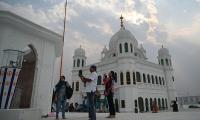Dr Fahad Ahmed claims only 528 policemen protecting five to six million residents
This month last year, four militants opened fire at the Bacha Khan University (BKU) near Charsadda and killed more than 20 people, including 17 students, and injured almost as many.
This was not the first such incident, as seven terrorists had attacked the Army Public School (APS) in Peshawar in December 2014 and left 141 people, including 132 students between the ages of eight and 18, dead – the highest number of fatalities in any terrorist attack in Pakistan to date.
The APS attack resulted in implementation of apparently stricter security measures in the vicinities of educational institutions by the federal government and all the provincial administrations.
The tragic incident also prompted the Pakistani government to devise the National Action Plan, which combines foreign and domestic policy initiatives aimed at cracking down on and eventually purging the country of banned organisations.
The BKU attack, however, exposed the ineffectiveness of the action plan and regrettably gave rise to the impression that no lessons had been learnt from the APS massacre.
In 2015 several private schools in Karachi came under grenade attacks, with the assailants leaving behind pamphlets warning the authorities against killing of militants in encounters, their execution and repatriation of Afghan refugees.
The Sindh government responded by closing the educational institutions and vowed once again that better measures would be adopted for their security. But so far, as The News learnt recently, no concrete plan has been finalised to keep that promise.
The schools were targeted in Gulshan Town, North Nazimabad, Baldia Town and Orangi Town; of them Gulshan Town in the East zone has the highest number of public universities and private schools, colleges and universities.
During an official meeting in December 2014, then DIG (East) Munir Ahmed Sheikh had mentioned that there were around 2,000 educational institutions, including the NED University of Engineering & Technology and the University of Karachi (KU), in his zone.
SSP (Gulshan) Dr Fahad Ahmed told The News that there were nine police stations in the town but only 528 policemen – including constables, head constables, assistant sub-inspectors and inspectors – to protect the five to six million residents, excluding regular visitors and the daily inbound and outbound flow of traffic.
According to international policing standards, he said, the ratio of policemen to people should be 1:450, adding that in many European and other developed countries the ratio was 1:250 but in Gulshan Town it stood at an alarming 1:10,000.
SSP Ahmed said the police force worked in two shifts and most of the available personnel were deputed to safeguard the people’s lives and properties, but the 1:10,000 ratio clearly showed how difficult it was for them to carry out their responsibilities.
“Only when five to six thousand able-bodied people are inducted into the Gulshan Town police force, the ratio would be 1:1,000. There would still be a huge shortage of personnel to protect the entire locality. The crime rate can only be minimised if the ratio matches the international standard.”
He said the available police force was tasked with safeguarding all the leading universities – including NED; KU; the Federal Urdu University of Arts, Science & Technology (Gulshan campus), the Sir Syed University of Engineering & Technology; the Usman Institute of Technology, the Habib University, the Bahria University and the Dow University of Health Sciences (Ojha campus) – the Pakistan Space & Upper Atmosphere Research Commission, the Civic Centre, the Accountant General Sindh Office, the National Stadium, the Pakistan Television Corporation, the old printing press, the central jail, the Aga Khan University Hospital, the Liaquat National Hospital, other public schools, colleges, universities and hospitals, a large number of banks, and residential and commercial units.
“The cluster of educational institutions cannot be properly monitored round the clock with the present police force. The shortage in the force is one of the major reasons that the crime rate in the town has gone up in the past many years.”
An aerial view of the commercial district of Pakistan's port city of Karachi. — AFP/FileWorld Culture FestivalThe...
This representational image shows the company's logo at a Nestle plant in Konolfingen, Switzerland September 28, 2020....
Former Federal Board of Revenue Chairman Shabbar Zaidi speaks at a press conference. — State Media/FileShakila...
Health workers busy in Dengue spray during a fumigation campaign in Karachi on October 16, 2024. — PPI In a meeting...
This image shows Karachi Police personnel and commandoes standing guard on November 29, 2023. —...
Police officials arrest protesters during the protest demonstration of the Baloch Yakjehti Committee for recovery of...







